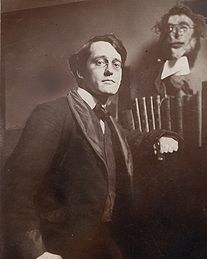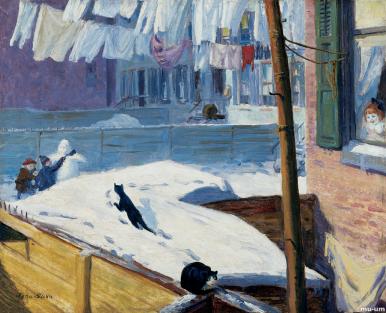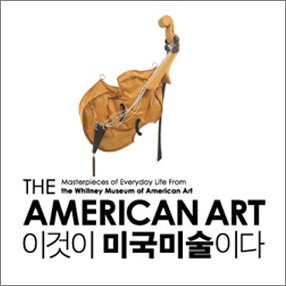
단체전
2011, 이것이 미국미술이다 ; 휘트니미술관展, 국립현대미술관 덕수궁관, 서울
추가정보
John Sloan was born in Lock Haven, Pennsylvania, in 1871, to James Dixon, a man with artistic leanings who made an unsteady income in a succession of jobs, and Henrietta Sloan, a schoolteacher from an affluent family.[3] Sloan grew up in Philadelphia, Pennsylvania, where he lived and worked until 1904, when he moved to New York City. He and his two sisters were encouraged to draw and paint from an early age. In the fall of 1884 he started high school at Central High School in Philadelphia, where his classmates included William Glackens and Albert C. Barnes.
In the spring of 1888, his father experienced a mental breakdown that left him unable to work, and Sloan became responsible, at the age of 16, for the support of his parents and sisters. He dropped out of school in order to work full-time as an assistant cashier at Porter and Coates, a bookstore. His duties were light, allowing him many hours to read the books and examine the works in the store's print department. It was there that Sloan created his earliest surviving works, among which are pen and ink copies after D?er and Rembrandt. He also began making etchings, which were sold in the store for a modest sum. In 1890, the offer of a higher salary persuaded Sloan to leave his position to work for A. Edward Newton, a former clerk for Porter and Coates who had opened his own stationery store. At Newton's, Sloan designed greeting cards, calendars, and continued with his etchings. In that same year he also attended a night drawing class at the Spring Garden Institute, which provided him his first formal art training.
He soon left Newton's business in quest of greater freedom as a freelance commercial artist, but this venture produced little income, leading him in 1892 to take a job in the art department at The Philadelphia Inquirer where he worked as an illustrator. Later that same year, Sloan began taking evening classes at the Pennsylvania Academy of the Fine Arts under the guidance of Thomas Pollock Anshutz. Among his fellow students was his old schoolmate William Glackens.
At a Christmas party in 1892, Sloan met Robert Henri, a charismatic advocate of artistic independence who became a mentor to him. From this point, Sloan began painting seriously, and the two of them have been regarded as the driving force behind the Ashcan School that helped to redefine American Art.
Towards the end of 1895, Sloan decided to leave The Philadelphia Inquirer to work in the art department of The Philadelphia Press. His schedule was now less rigid, allowing him more time to paint. Henri offered encouragement, and often sent Sloan reproductions of European artists, such as Manet, Hals, Goya and Velazquez.
In 1898, the socially awkward Sloan was introduced to Anna Maria (Dolly) Wall, and the two fell immediately in love. In entering into a relationship with her, Sloan accepted the challenges posed by her alcoholism and her sexual history which included prostitution뾞lthough Dolly worked in department store by day, Sloan met her in a brothel. The two were married on August 5, 1901, providing Sloan with an affectionate partner who believed in him absolutely, but whose lapses and mental instability led to frequent crises.
By 1903 he had produced about sixty oil paintings in total. In April 1904, Sloan moved to New York City, and soon found quarters in Greenwich Village where he painted some of his best-known works, including McSorley's Bar, Sixth Avenue Elevated at Third Street, and Wake of the Ferry. His time in New York was his most prolific period, but he sold little, and he continued to rely on his earnings as a freelancer for The Philadelphia Press, for which he continued to draw weekly puzzles until 1910. By 1905 he was supplementing this income by drawing illustrations for books (including The Moonstone) and for such journals as Collier's Weekly, Good Housekeeping, Harper's Weekly, The Saturday Evening Post, and Scribner's.
A doctor who was consulted in an effort to help Dolly overcome her drinking problem suggested a scheme to Sloan: he was to start a diary in which he would include his fondest thoughts of her, with the expectation that she would surreptitiously read it and be freed of her disabling fear that Sloan would leave her. Spanning the period from 1906 to early 1913, the diary soon grew beyond its initial purpose, and its publication in 1965 supplied researchers with a detailed chronicle of Sloan's activities and interests.
June 1914 cover of The Masses depicting the Ludlow Massacre.Sloan's growing discontent with what he called "the Plutocracy's government" led him to join the Socialist party in 1910.[13] He became the art editor of The Masses with the December 1912 issue, and contributed drawings to other socialist publications such as the Call and Coming Nation. As Sloan disliked propaganda, his work for these magazines often lacked overt political content. This was unacceptable to a faction of his fellow editors at The Masses, causing him to resign his position with the journal in 1916. He later became disenchanted with the Communist Party in America, although he remained hopeful that the Soviet Union would succeed in creating an egalitarian society.
In 1913, Sloan participated in the Armory Show. He served as a member of the committee that organized it, and also exhibited two paintings and five etchings. In that same year, the important collector Albert C. Barnes purchased one of Sloan's paintings; this was only the fourth sale of a painting for Sloan (although it has often erroneously been counted as his first). For Sloan, exposure to the European modernist works on view in the Armory Show initiated a gradual move away from the urban themes he had been painting for the previous ten years. In 1914?5, during summers spent in Gloucester, Massachusetts, he painted landscapes outdoors in a new, more colorful style influenced by Van Gogh and the Fauves.
Beginning in 1914, Sloan taught at the Art Students League, continuing for about ten years. Sloan also taught briefly at the George Luks Art School. His students respected him for his practical knowledge and integrity, but feared his caustic tongue; as a well-known painter who had nonetheless sold very few paintings, he advised his students, "I have nothing to teach you that will help you to make a living".
The summer of 1918 was the last he spent in Gloucester. For the next 30 years, he spent four months each summer in Santa Fe, New Mexico, where the desert landscape inspired a new concentration on the rendering of form. Still, the majority of his works were completed in New York. He developed a strong interest in Native American arts and ceremonies, and became an advocate of Indian artists. He also championed the work of Diego Rivera, who he called "the one artist on this continent who is in the class of the old masters." The Society of Independent Artists, which Sloan had co-founded in 1916, gave Rivera and Jos?Clemente Orozco their first showing in the United States in 1920.
In 1943, his wife, Dolly, died of coronary heart disease. The next year, Sloan married Helen Farr, who is responsible for most of the preservation of his works. On September 7, 1951 John Sloan died of cancer in Hanover, New Hampshire.


